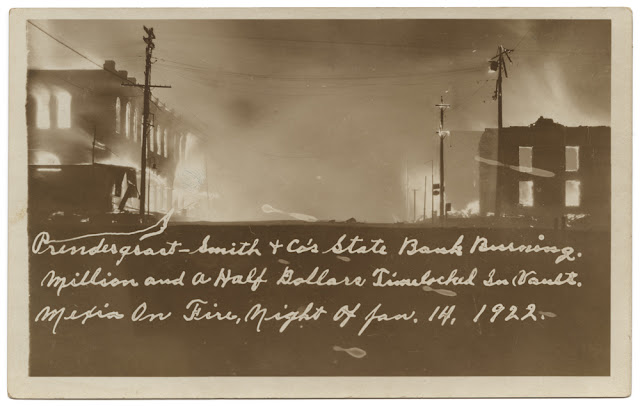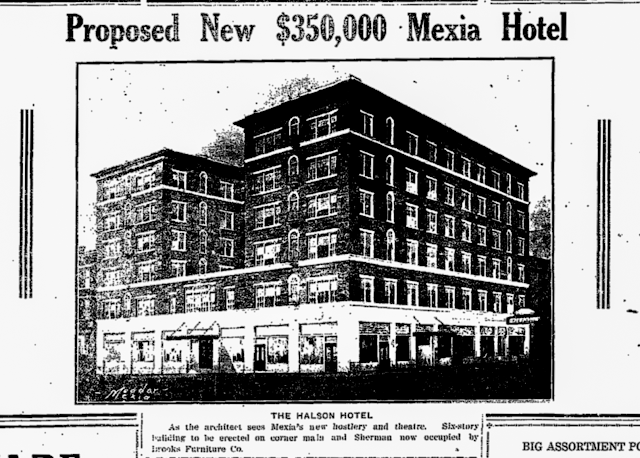The Great Mexia Fire of 1922
Mere days after Governor Neff declared Martial Law in Mexia, a fire swept through two blocks in the heart of downtown Mexia Saturday night, January 14, 1922. Possibly due to the newsmen who had descended on the city to cover the military presence in the town, photos were taken at the height of the flames.
Eight buildings and more than 100 businesses were destroyed.
The Corsicana Daily Sun put out an Extra edition Saturday night with details of the timeline (and clearly a hope they would attract some of the burned out businesses...)
The fire originated in the Ross & Green building at 6:30, and spread to the adjacent buildings and jumped across the street to burn out the facing block's side by 8:00 that evening, due to the critical and ongoing water shortage in the city. "The firemen have resorted to the use of dynamite in their efforts to control the flames."
At 7:42 "just before the Telephone building caved in" a call reached Corsicana to the fire chief for assistance.
This puzzles me a bit, as that would put the Corsicana firemen arriving into Mexia no earlier than 8:45, by their own later account of the record run, and the piece notes the accounts were coming from men who had returned to Corsicana by 9:30, which would require their departure from Mexia at almost exactly the time of their arrival,
Nevertheless, the newsmen were pronouncing the threat to the entire business district and a portion of its residential district from their 45 minute (maximum) visit to the town.
It should be noted that "Telephone Girls" were also vital to the WWI effort, thanks to the insistence of General Pershing, who himself had been in town the prior week. If you don't know this story, be sure to click here for a primer.
Short version: women were able to connect five times as many calls in the same time period as male soldiers and General Pershing fought for their presence on the front lines in the critical need for communications. They were denied status as veterans until 1977 when most had already died. A book, documentary, and now an off-Broadway play debuting next month, some 100 years after the end of the war, is finally giving these women their due.
But I digress. These four women deserve their due as well.
Their names: Minnie Stewart, Helen Sebastian, Lillian Phillip, and Miss Harp
"all animated with the spirit that carried The Light Brigade forward" may well have saved Mexia that night.
I am thankful the Mexia Evening News published their account January 21, 1922 so we can honor them by name.
In a piece written in 1955 for the Waco Times Herald in an effort to capture eye-witness memories of the Mexia Boom years, Nanine Simmons notes, "a customer there at the time [in the restaurant where the fire originated] claimed he saw the cook kick a recalcitrant kerosene stove, which wasn't working right, and it exploded."
(The 1955 piece noted no one could quite remember which girls were on duty.)
Mrs. Simmons recalled the Sunday after the fire:
There was only an eight inch line supplying Mexia at that time, and with the boom, water that would fill overnight in the standpipe was drained by 6:00 every morning as people filled their bathtubs up to have water the rest of the day. Some water was obtained from the ice plant at the edges of the blaze to keep it from spreading, but the two blocks already on fire simply had to burn themselves out.
E.B. Mosley, would would serve as Mexia's mayor, would have his memory of the fire in 1955 set down in the account in the Waco paper. He recalled he had just arrived from Georgia to manage the Neece Lumber Company, largest of the thirty-three lumber concerns during the boom, was eating dinner with Reuben Neece when the fire started:
In the light of day Sunday morning, The Ruins were photographed

The 1955 account included the memory of the bank's being able to open its doors the very next Monday relocated in the basement of the Cheeves Brothers (later J.C. Penney) from counters made of 2x4s and cages of chicken wire. The currency would be stored overnight at City National Bank.
"Each morning and afternoon employees would carry around $250,000 in cash across the muddy street, pilled atop a contraption with handles similar to a battlefield litter." Noe Hollingsworth, who came to the bank during its temporary quarters recalls no guards were present.
The Mexia Evening News continued its coverage the following day focused on the resilience of the town
Corsicana followed up on the 17th with more details, apparently having to settle for only the two blocks burned, and curiously they likely knew the true extent even at the time they were printing their Extra edition on the night of the 14th, as they write, "the fire was practically under control when the local firemen arrived" leaving the Corsicana boys to work mop up around the perimeter.
From Davenport, Iowa "Mexia, Texas, Swept by Flames, Business Section is Destroyed"
From Mansfield, Ohio, "Entire City May Go"
The Galveston Daily News seemed to be one of the most balanced portraits
and the following day it carried another column of information



































Comments
Post a Comment